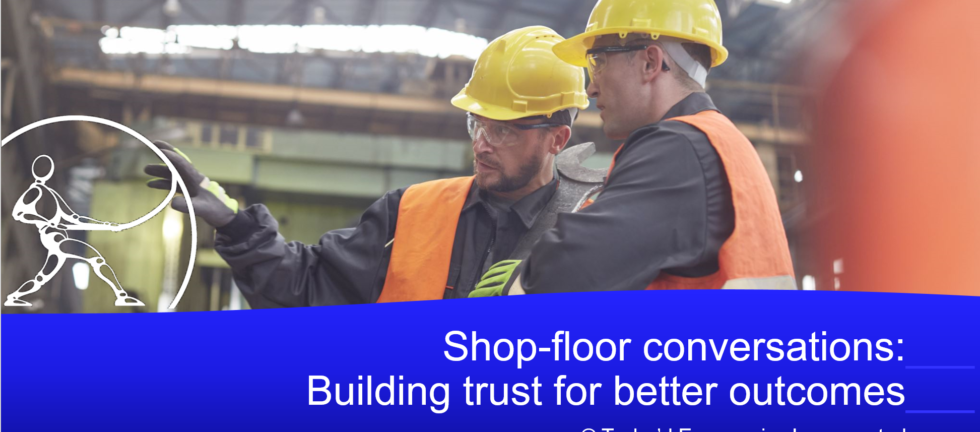As ergonomists, our success hinges on more than just technical expertise—it’s also about building trust and rapport with the workers we aim to help. Without trust, employees might hold back critical information about how they really perform their jobs, and without accurate data, our ability to recommend effective improvements is compromised.
When workers feel comfortable and understood, the conversation gets really interesting. They open up, revealing the nuances of their work routines, which are often more insightful than formal observations alone.
“Oops. I shouldn’t have done it like that.”
One common misconception we face is that employees think we’re there to judge their work techniques. While we do observe body mechanics, it’s rarely a case of poor habits on the worker’s part. Often, the root cause of awkward postures lies in poorly designed workstations. For example, a worker perched on the edge of the chair likely can’t lower the seat because the keyboard is too high, or a worker stooping to pick up parts might be leaning into a deep bin. Our goal is to understand the constraints that drive these positions, so we can offer meaningful solutions that reduce discomfort and injury risks.
“If I’d known you were coming, I’d have brushed my hair.”
Ergonomists often get mistaken for auditors, especially when we bring out the camera. Workers worry about looking unprepared or being scrutinized. But for us, photos aren’t about aesthetics—they’re about biomechanics. We’re not interested in hairstyles or fashion choices; we’re focused on the alignment of the body and the physical demands of the job. Capturing those moments helps us document postures, forces, and other risk factors that contribute to musculoskeletal disorders (MSDs).
“Are you doing a time study?”
Another common misunderstanding is that workers think we’re there to do a time study, aiming to increase productivity by eliminating idle time. While it’s true that ergonomics can lead to greater efficiency, our primary focus is on worker safety and comfort. We’re looking to minimize the physical demands that lead to fatigue and injuries—not to eliminate necessary recovery time. If we can make a job more efficient and reduce the risk of MSDs, that’s a win-win.
“You should have been here yesterday!”
It’s always tempting for workers to point out the toughest days we’ve missed. But even if we’re not there to witness peak work demands, we aim to capture a representative snapshot of both typical and extreme conditions. By gathering information about peak and average work rates, weights, and task durations, we can still make informed assessments of risk factors like excessive force and awkward postures.
“Are we failing?”
The sight of someone with a clipboard or tablet often triggers anxiety. Workers fear that they’re being evaluated or graded. But as ergonomists, we’re not auditors. Our goal isn’t to “fail” anyone—it’s to identify risks and provide solutions that make the job easier, safer, and more comfortable. The more honest and open the workers are with us, the better we can “taylor” our recommendations to improve their well-being.
“This is a bad job, isn’t it?”
Workers often want to know right away if their job is a problem. But until we’ve gathered all the data and analyzed it, we can’t say for sure if a job presents a high risk of injury. Much like a doctor or mechanic, we need to assess the full picture before making any conclusions. By combining direct observations with worker input, we can build a comprehensive understanding of the job and its demands.
Building Trust for Better Outcomes
Ultimately, the key to successful ergonomics intervention is trust. When employees trust us, they’re more likely to show us how they really perform their jobs, allowing us to gather accurate data and develop effective solutions. Our role isn’t to judge or audit performance—it’s to help. By collaborating with workers and safety professionals, we can reduce ergonomics hazards, prevent injuries, and create safer, more sustainable workplaces.
FAQs:
- How can ergonomists actively build trust with workers who are initially resistant or skeptical?
- Building trust starts with clear communication. Ergonomists should explain their role from the outset, emphasizing that their purpose is to improve comfort and safety, not to criticize or judge. Engaging workers in conversations about their experiences and showing genuine interest in their challenges can break down barriers. Being approachable, listening actively, and demonstrating respect for their expertise can go a long way. Small gestures, like explaining why you’re using a camera or how your recommendations will benefit them, can also foster trust.
- What steps should ergonomists take if they do encounter employees who are hiding or misrepresenting their work processes due to lack of trust?
- If ergonomists suspect that workers are withholding information, they should address it diplomatically. Acknowledging that some tasks may be more difficult to show or explain is a good start. Ergonomists can also ask open-ended questions that invite more detailed responses or encourage workers to walk through different scenarios. Engaging supervisors and safety representatives in the conversation might help create a more open environment. If trust remains an issue, it can be useful to schedule follow-up visits to capture different aspects of the job and ensure the worker feels more comfortable over time.
- How can ergonomists ensure that their assessments are accurate when only “snapshot” observations are possible?
- To ensure an accurate assessment from limited observations, ergonomists should combine what they observe with thorough interviews and data gathering. Workers can provide valuable input on peak and low-demand periods, so asking about a variety of work conditions is crucial. Ergonomists can also review records of job demands, task durations, and environmental conditions. If possible, multiple site visits or video recordings of different shifts can help create a fuller picture. Cross-referencing direct observations with this additional information allows a more comprehensive risk assessment.


